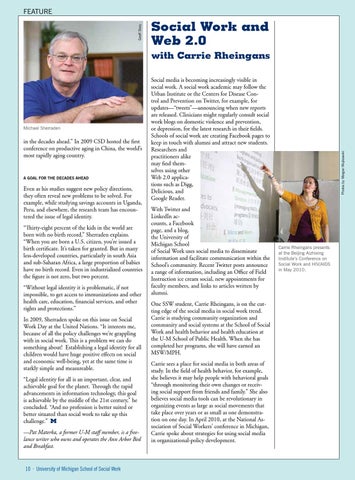Geoff Story
FEATURE
Social Work and Web 2.0 with Carrie Rheingans
in the decades ahead.” In 2009 CSD hosted the first conference on productive aging in China, the world’s most rapidly aging country.
A goal for the decades ahead
Even as his studies suggest new policy directions, they often reveal new problems to be solved. For example, while studying savings accounts in Uganda, Peru, and elsewhere, the research team has encountered the issue of legal identity. “Thirty-eight percent of the kids in the world are born with no birth record,” Sherraden explains. “When you are born a U.S. citizen, you’re issued a birth certificate. It’s taken for granted. But in many less-developed countries, particularly in south Asia and sub-Saharan Africa, a large proportion of babies have no birth record. Even in industrialized countries the figure is not zero, but two percent. “Without legal identity it is problematic, if not impossible, to get access to immunizations and other health care, education, financial services, and other rights and protections.” In 2009, Sherraden spoke on this issue on Social Work Day at the United Nations. “It interests me, because of all the policy challenges we’re grappling with in social work. This is a problem we can do something about! Establishing a legal identity for all children would have huge positive effects on social and economic well-being, yet at the same time is starkly simple and measureable. “Legal identity for all is an important, clear, and achievable goal for the planet. Through the rapid advancements in information technology, this goal is achievable by the middle of the 21st century,” he concluded. “And no profession is better suited or better situated than social work to take up this challenge.” —Pat Materka, a former U-M staff member, is a freelance writer who owns and operates the Ann Arbor Bed and Breakfast.
10 · University of Michigan School of Social Work
With Twitter and LinkedIn accounts, a Facebook page, and a blog, the University of Michigan School of Social Work uses social media to disseminate information and facilitate communication within the School’s community. Recent Twitter posts announce a range of information, including an Office of Field Instruction ice cream social, new appointments for faculty members, and links to articles written by alumni. One SSW student, Carrie Rheingans, is on the cutting edge of the social media in social work trend. Carrie is studying community organization and community and social systems at the School of Social Work and health behavior and health education at the U-M School of Public Health. When she has completed her programs, she will have earned an MSW/MPH. Carrie sees a place for social media in both areas of study. In the field of health behavior, for example, she believes it may help people with behavioral goals “through monitoring their own changes or receiving social support from friends and family.” She also believes social media tools can be revolutionary in organizing events as large as social movements that take place over years or as small as one demonstration on one day. In April 2010, at the National Association of Social Workers’ conference in Michigan, Carrie spoke about strategies for using social media in organizational-policy development.
Photos by Morgan Wujkowski
Michael Sherraden
Social media is becoming increasingly visible in social work. A social work academic may follow the Urban Institute or the Centers for Disease Control and Prevention on Twitter, for example, for updates—“tweets”—announcing when new reports are released. Clinicians might regularly consult social work blogs on domestic violence and prevention, or depression, for the latest research in their fields. Schools of social work are creating Facebook pages to keep in touch with alumni and attract new students. Researchers and practitioners alike may find themselves using other Web 2.0 applications such as Digg, Delicious, and Google Reader.
Carrie Rheingans presents at the Beijing Aizhixing Institute’s Conference on Social Work and HIV/AIDS in May 2010.
